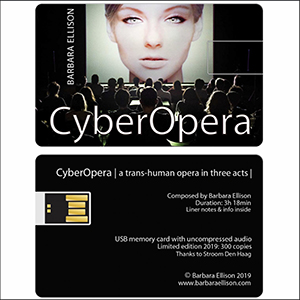 Opera is not exactly a style of music that has overlapped much with modern electronic and experimental genres. Perhaps it is the long-form nature, or the innately organic nature of works built heavily around the human voice, but either way, it has not been a major crossover style in my experience. As an outgrowth of her CyberSongs project, Barbara Ellison has decided to tackle this challenge. Using computer modeled speech and instrument samples, along with a healthy dose of processing and audio treatments, the final product is a diverse mix that clearly draws from operatic structures and elements, but results in something that transcends the style entirely.
Opera is not exactly a style of music that has overlapped much with modern electronic and experimental genres. Perhaps it is the long-form nature, or the innately organic nature of works built heavily around the human voice, but either way, it has not been a major crossover style in my experience. As an outgrowth of her CyberSongs project, Barbara Ellison has decided to tackle this challenge. Using computer modeled speech and instrument samples, along with a healthy dose of processing and audio treatments, the final product is a diverse mix that clearly draws from operatic structures and elements, but results in something that transcends the style entirely.
CyberOpera is a three act, 3+ hour endeavor that is presented as uncompressed audio via USB card.Besides the added sound quality of 24bit/48k, it also allows her to present a work that is consistent with the length of other operas.The concept itself grew out of Heropera, an experimental opera that was largely improvised by the Trickster collective, consisting of Ellison, Nina Boas, Nathalie Smoor, Ieke Trinks, and Marielle Verdijk, but transposed to Ellison's CyberSongs innovative framework of inorganic voices and processed speech emphasis.
Ellison uses voice throughout the three acts, although rarely presented in a decipherable context.It is mostly a multitude of chopped fragments and syllables, sometimes to the point in which it is no longer identifiable as anything but a few bits of data.The opening narration is about the only time in which it sounds "normal," but even from there the female voice used has an inhuman lilt to it that heralds what is to come.
The first half of the first act features her tearing this voice apart into stuttering, repeated words, cut up syllables, etc.The technique has been heard before in many forms of media to depict a glitching robot or computer, but her careful use of the fragments, especially when shaping them into somewhat musical rhythms and sequences, is where her talent shines through clearly.Voices are processed into instruments, and the second part of the first act becomes sweeping orchestral strings, but again, with a particularly inorganic quality to the sound.
Act 2 begins with a metronome-like harpsichord sound that sounds mechanically repetitive at first listen, but closer inspection reveals a lot more in the way of subtle changes and variations to be heard, perhaps demonstrating how "human" technology can sound when calculated imperfections are introduced.Voice bits come in, and everything builds to a louder, more forceful dynamic, as operas do.These skips and glitches at times lock into conventional electronic music structures, but always feature a distinctly idiosyncratic sound to them.
The second part of Act 2 begins with voice in erratically paced loops, but eventually relents to mangled orchestral samples and fizzing, crackling noises and what sounds like a bit of piano here and there.The pitch bending that concludes the second part gives a bit of quirk to the sound, but for the third, Ellison is working with buzzing, metallic tones and more conventional operatic voices.Tight, cut up loops and processed, deeper voices that are perhaps the most traditional opera elements in this entire set, and it functions extremely well.
Act 3 features Ellison emphasizing the abstract sounds largely during the first three (of six) parts.Part one is a mass of skittering, unidentifiable sounds and white noise hiss that builds in volume.There are bits of what could be flute or wind chimes that sneak through but for the most part, it is a noisier work.Dramatic voices appear in part two, but otherwise it is the opposite of the first:minimal, open sounds with the occasional dissonant bit that stabs through.The sound is reminiscent from collaborator Francisco López (who also mastered this recording), but it is still distinctly Ellison’s work.The third part’s first half is probably one of the more abrasive moments here:lots of harsh, cut up voice bits played with intense repetition, while the second half is more spacious, musical and even features some emulated symphonic percussion.
The remaining three parts feature Ellison returning to the more voice-focused first act.Part four is at first a slew of organic, crackling snaps and textures, later fleshed out by warm, sustained tones and voice layers.For the fifth part, Ellison throws in more, but varied, voices and with the occasional harpsichord, is obviously building to the work’s dramatic conclusion. This is blended into the final part, where the varied voices are mixed with digital drums and rhythmic programming, transitioning from rhythmic structures to dramatic tones, before ending the whole performance on a hushed note.
Like a conventional opera, CyberOpera can be a daunting experience.With the lengthy runtime, and at times intentionally difficult sounds and structure, it is anything but a light work.However, I was extremely impressed with the uniqueness of it, and the subversion of a genre into an entirely different form.Had Barbara Ellison simply attempted to replicate a conventional opera with sampled instruments and speech synthesis software, I imagine she would have been successful.However, by doing that I think the result would just seem like a technological demonstration, and not the distinct and creative work that she went for, and succeeded greatly, in doing.
Read More

